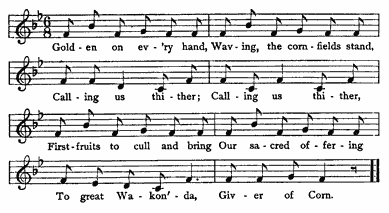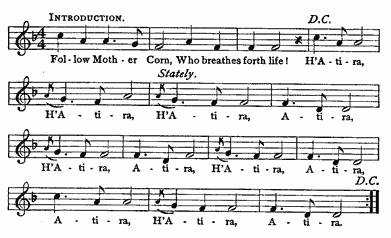The Life of the Corn
by Alice C. Fletcher
Dance V - Honor to Mother Corn
Introductory Note.—This dance represents the bringing of the "first-fruit offering" of the corn from the seven little hills that were ceremonially planted after the dead leaves of winter had been cleared away. The dancers who follow the seven leaders carrying the cornstalks represent the people in triumphal procession in honor of Corn as "Mother breathing forth life." Both words and music of the song for this procession are taken from a great religious ceremony of the Pawnee wherein Corn is spoken of as A-ti-ra, Mother, with the prefix H' signifying breath, the sign of life. "H'A-ti-ra" ("Mother breathing forth life") is repeated over and over and is the only word used in this song. The repetition is not an idle procedure but an awakening of echoes in the native mind, of all that Corn has meant to his ancestors and race during the centuries. The repeated words imply contemplation on the subject. This song when heard sung by a hundred or more could not fail to impress one with its majestic fervor. The beautiful, bountiful maize giving its life that others might enjoy life, on another plane, is here reverently and joyously proclaimed "Mother."
Properties.—Green and other bright colored scarfs or mantles, as many as there are dancers, boys and girls, also wreaths made of long leaves like those of the cornstalk; these can be manufactured from green paper. Tall yellow plumes, similar to the tassel of the corn, and fastened to the wreath in such manner that when the wreath is worn the plume will stand above the forehead. Seven cornstalks, or wands so wound with green as to appear like the stalk of the corn with its tassel.
Directions.—All the dancers should be wrapped in their mantles and have on their wreaths, the erect tassel plume standing directly over the middle of the forehead. Boys and girls must mingle in this dance. All dress as before, with the addition of the mantles. Implements, pouches and bows and arrows are not used. Of the seven who are to lead, four should be boys and three girls. When leading the procession and carrying the cornstalks, the first line of four should be a boy, two girls, a boy; the second line of three should be a boy, a girl, a boy. These seven must wear green robes or mantles and hold the cornstalks, with their hands draped by the mantle. The other dancers can wear green or other colored mantles or scarfs. The boys must sing the songs, for the volume of sound must be full in order to produce the true effect of this impressive ceremony. The seven dancers who have been selected to act as leaders should stand in a group by themselves in front of the other dancers, who are in loose groups at the rear. On the space which heretofore in these dances has represented the "field," the seven cornstalks or wands should be laid in a windrow on the ground. When ready to begin the dance the dancers should be discovered in the two groups as already described, talking quietly in dumb show.
The seven leaders, who are in the front group by themselves, appear to consult together; then, led by one of their number, sing the following song:
Song No. 1
1
Golden on ev'ry hand,
Waving, the cornfields stand,
Calling us thither;
Calling us thither,
First-fruits to cull and bring
Our sacred offering
To great Wakon'da,
Giver of Corn.

During the singing the seven leaders stand together wrapped in their green mantles. All the other dancers are grouped at a little distance back, still talking as at first in dumb show. At the third line they stop talking, at the fourth line they give attention to the seven leaders, at the fifth line they join in the song. During the singing of this stanza there should be no change in the relative positions of the two groups, but during the singing all who sing should keep up a gentle rhythmic swaying of the body.
2
Now to the field we hie,
Where stands the corn so high,
Calling us thither;
Calling us thither,
First-fruits to cull and bring
Our sacred offering
To great Wakon'da,
Giver of Corn.
The seven leaders, at the beginning of the first line of the second stanza, slowly fall into line and with deliberate rhythmic steps move toward the "field," reaching it by the fifth line, and while singing that line they should pick up the cornstalks and hold them, with their hands draped with their green mantles, high to the front.
At the close of the first stanza the other group of dancers should resume a dumb show of speaking to one another until the third line of the second stanza, when they change their attitude and give attention; at the fourth line they join in the song, and at the fifth move toward the "field" where are the seven leaders. By the close of the second stanza all the dancers should be in one group at the "field."
All the dancers stand there at the "field" a moment in silence. Then the seven leaders sing the introduction to the following Processional Song:
Song No. 2
Introduction: Follow Mother Corn,
Who breathes forth life!
Chorus: H'A-ti-ra, H'A-ti-ra, H'A-ti-ra, A-ti-ra,
H'A-ti-ra, A-ti-ra, H'A-ti-ra, A-ti-ra,
A-ti-ra, H'A-ti-ra, A-ti-ra.

This song is retained as sung in the original Pawnee ceremony; the meaning has already been explained.
The introduction is sung by the seven leaders, who advance in two rows, four in the first, three in the second, and in this manner they lead the Processional Dance. At the chorus all the other dancers fall in behind the leaders, either in couples or singly, every one singing. All steps must be rhythmic and in time with the music. The seven leaders move steadily, also in time with the music, as they hold the cornstalks high, while the followers wave their scarfs or mantles and dance happily and lightly, but with dignity. The picture should be one of contrast as the procession takes its way among trees and through the sunny fields, the seven moving evenly, with the corn held high, and the joyous, fluttering group of dancers following.
The Life of the Corn culminates in a delight of color, movement and song.